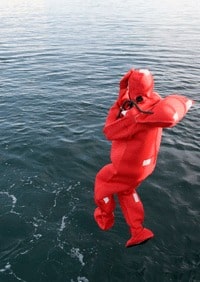Blog Post
Understanding Immersion Suit Purpose: A Comprehensive Guide
Posted By: Harsh Bamnolia
Posted On : 20-Feb-2025

Understanding Immersion Suit Purpose: A Comprehensive Guide
Understanding Immersion Suit Purpose
The immersion suit purpose is crucial in maritime safety, ensuring that seafarers and passengers are protected in emergency situations.
Designed to provide thermal insulation and buoyancy, immersion suits are a critical component of life-saving equipment aboard ships.
These suits help individuals survive in cold water, reducing the risk of hypothermia and increasing the chances of rescue.
Understanding the immersion suit purpose and its role in maritime safety is essential for compliance with SOLAS regulations and for ensuring personal safety at sea.
Immersion suits are mandatory for crew members aboard commercial vessels, fishing boats, and offshore platforms operating in cold environments.
The ability to withstand extreme temperatures and prevent water from entering is what makes them indispensable.
In harsh weather conditions, survival time in cold water without protective gear can be significantly reduced, making immersion suits an essential part of emergency preparedness plans.
Why Is an Immersion Suit Important?
Immersion suits are life-saving devices designed to keep a person warm and afloat in cold water. They serve multiple functions:
Thermal Protection: Immersion suits provide insulation to protect against hypothermia in freezing waters.
Buoyancy: These suits help keep individuals afloat, preventing drowning.
Waterproofing: They are designed to keep the wearer dry, reducing the risk of cold shock.
Visibility: Most immersion suits come in bright colors with reflective tape to enhance visibility in rescue operations.
Regulatory Compliance: According to SOLAS (Safety of Life at Sea) regulations, ships must carry approved immersion suits for all crew members.
Aside from these critical functions, immersion suits also ensure that individuals remain conscious in freezing waters.
Without proper protection, a person exposed to cold water for prolonged periods may lose motor function and succumb to cold incapacitation, making rescue difficult.
This is why SOLAS mandates strict compliance in carrying and maintaining immersion suits aboard ships.
Features of an Immersion Suit
Modern immersion suits have specific features that enhance their functionality:
Material and Construction:
Made from neoprene or other waterproof materials to provide insulation.
Sealed seams to prevent water ingress.
Durable zippers and closures to maintain waterproof integrity.
Buoyancy and Floatation:
Inbuilt buoyancy to keep the wearer afloat without an additional lifejacket.
Some models have inflatable chambers for extra buoyancy.
Suits may include integrated head support to maintain an upright position in water.
Thermal Protection:
Designed to retain body heat for extended survival in cold waters.
Can withstand temperatures as low as -30°C (-22°F) in dry conditions.
Some suits feature multiple layers for enhanced insulation.
Size and Fit:
Available in different sizes to fit various body types.
Adjustable cuffs, hoods, and seals for a snug fit.
Some models offer universal fitment to accommodate all crew members.
Additional Safety Features:
Integrated whistle for attracting attention.
High-visibility colors with reflective tape.
Reinforced soles to prevent slipping.
Glove attachments to keep hands warm and functional.
Emergency pull cords for rapid donning in urgent situations.
Proper Maintenance and Inspection
To ensure immersion suits remain functional, regular maintenance and inspections are required. Crew members should inspect suits for damage, test zippers, and ensure all seals are intact before each voyage.
Periodic servicing by certified technicians can further extend the life of an immersion suit and guarantee compliance with safety regulations.
Immersion suits must also be stored properly to prevent degradation from exposure to sunlight, moisture, or mechanical stress.
Storage lockers should be dry, well-ventilated, and positioned where crew members can access suits quickly in case of emergency.
Conclusion
Understanding the immersion suit purpose is essential for ensuring maritime safety and regulatory compliance. These suits play a vital role in preventing hypothermia, providing buoyancy, and increasing survival rates during emergencies.
Ships and offshore installations must equip themselves with SOLAS-compliant immersion suits to protect crew members and passengers.
In an emergency, having the right survival gear can mean the difference between life and death. This is why choosing high-quality, tested, and certified immersion suits is crucial.
Crew members should be well-trained in donning the suits correctly and aware of the procedures to follow in case of an evacuation.
At Marinetech Safety & Shipping Corporation, we provide high-quality, SOLAS-approved immersion suits designed for maximum protection and comfort.
To explore our range of life-saving equipment, visit: https://marinetechss.com/supplies/life-saving-equipments.